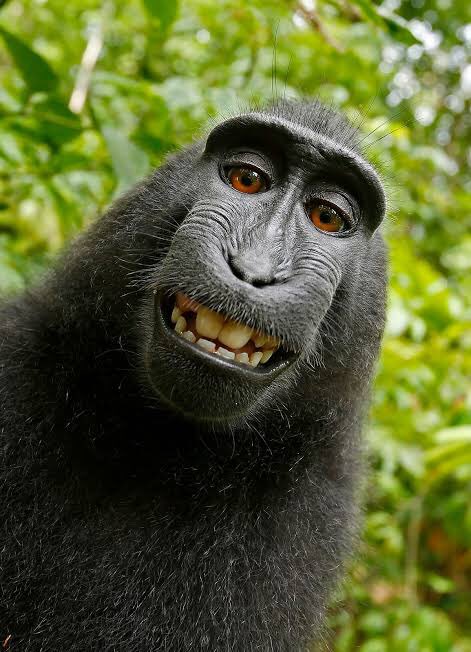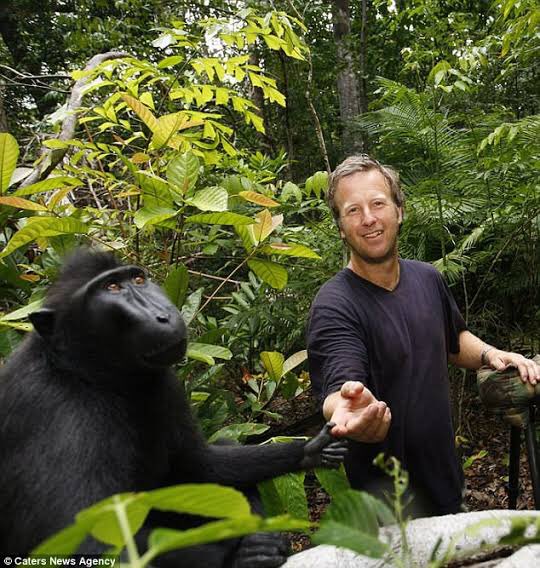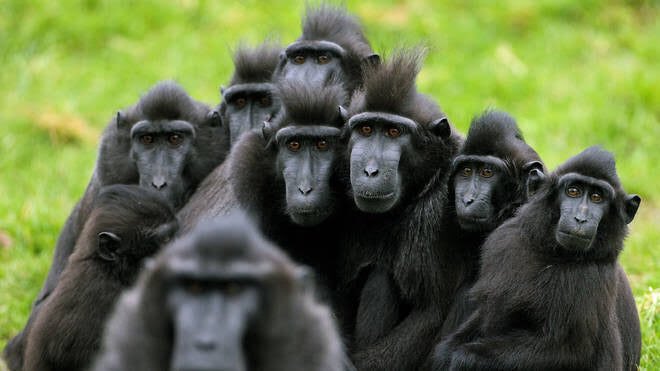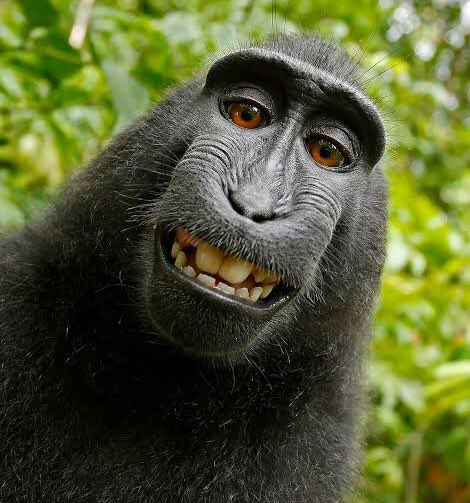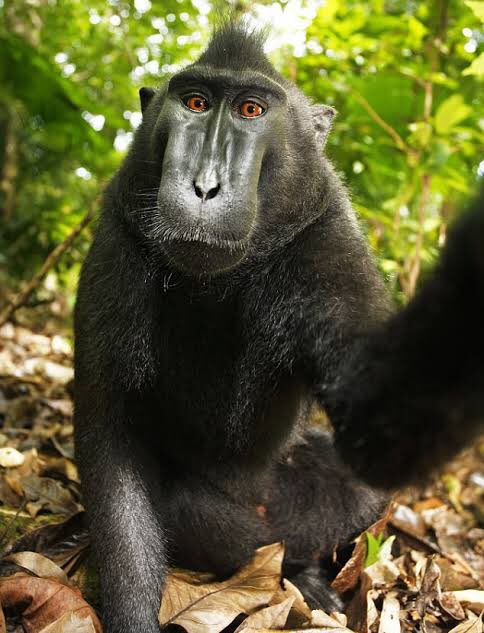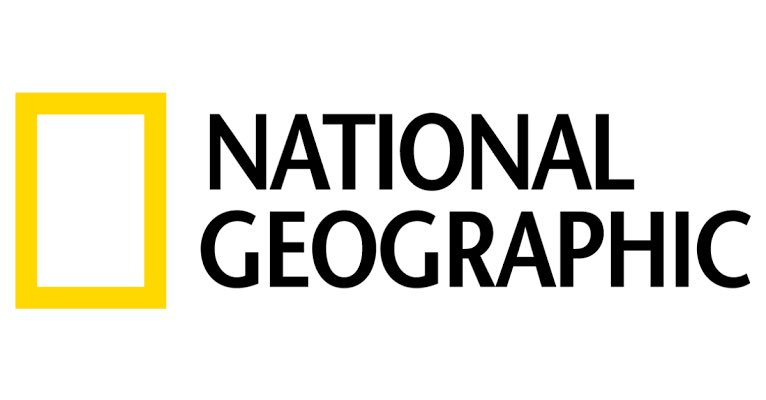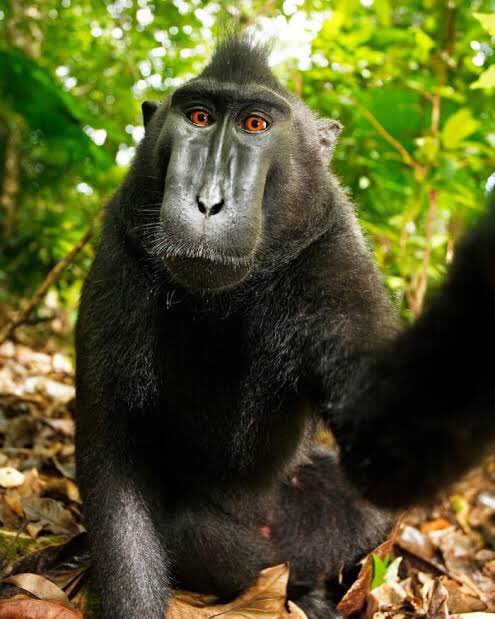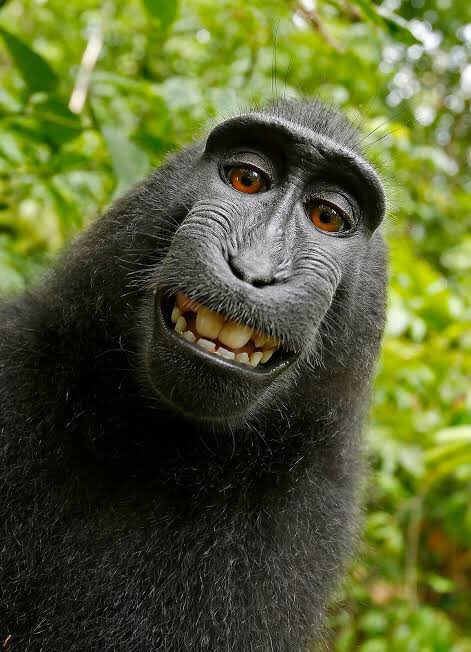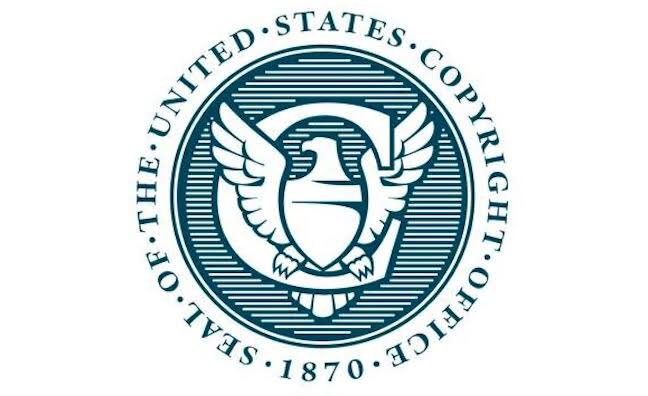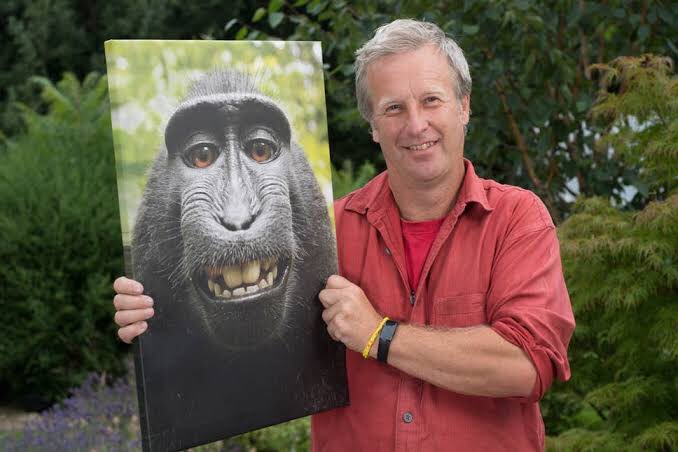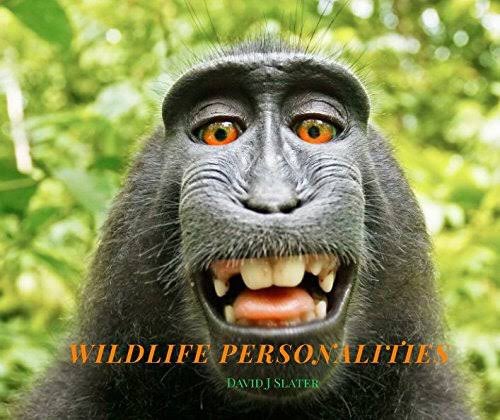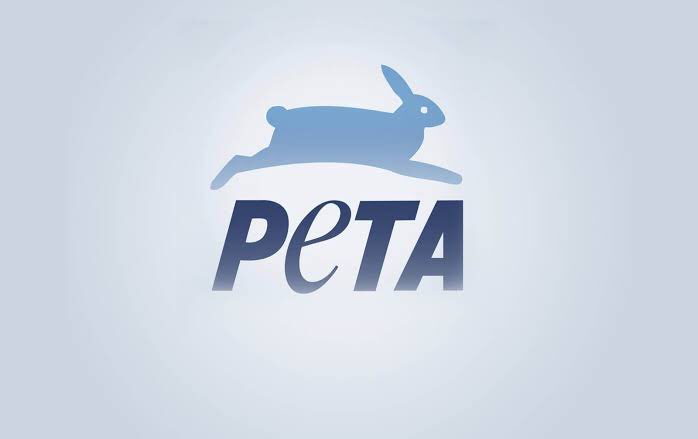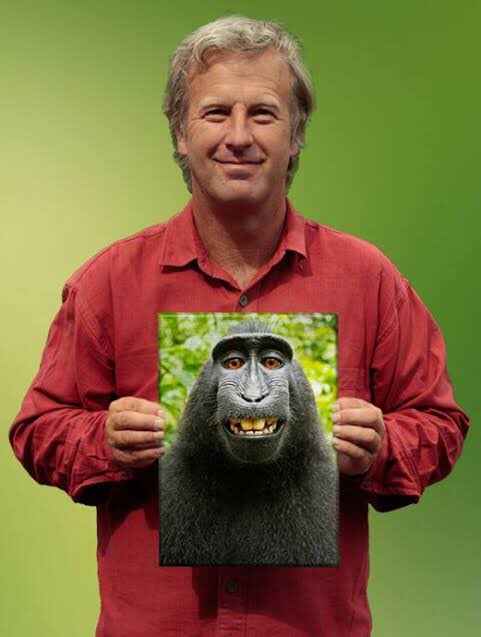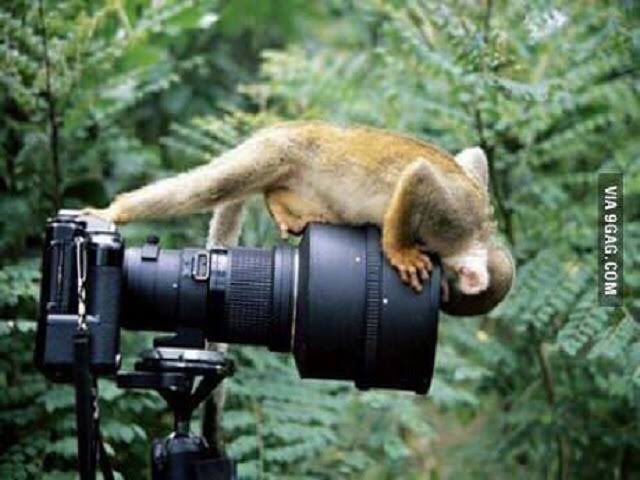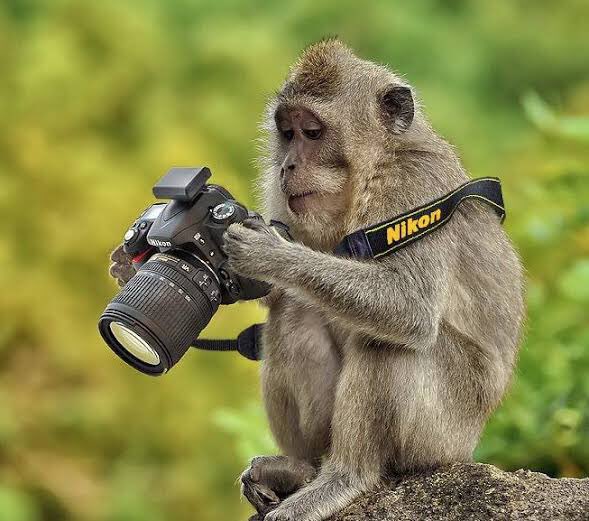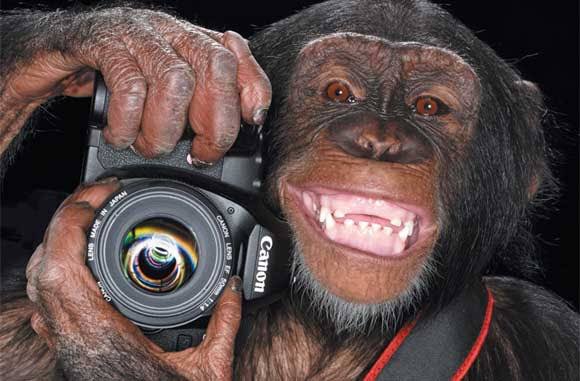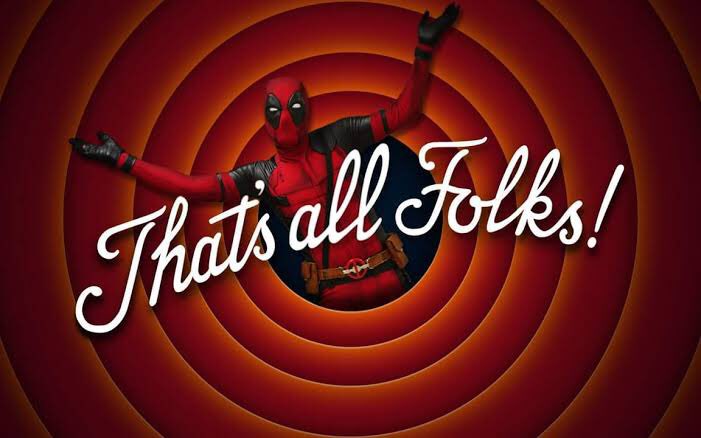Welcome to another addition of #IPThursday with your favourite lawyer. The following thread concerns the story of the famous Monkey Selfie, and whether or not an animal can own Copyright in a creative work?
Our story begins in July 2011. This man, David Slater a British wildlife photographer took a 3 week trip to Indonesia. His goal was to take pictures of macaque monkeys, a species of monkeys found in Indonesia. He had been doing so for a few years at this point.
He found a group of them in North Sulawesi, Indonesia and started following them around. I’m sure the poor monkeys thought this was incredibly strange. Like why is this human stalking us?!
Slater was fascinated by the monkeys and wanted to get close up shots. So, over the course of the next 3 days Slater did what most of us would not do for the perfect picture, he befriended the monkeys, got them to touch him, groom him and play with his............camera.
Anyways, he took a series of photos but they didn’t have “that thing” epic photos tend to have. Remember the Che Guevara picture? that was an epic photo. But as you can imagine, its very hard getting monkeys to strike a pose.
So Slater came up with an idea. Perhaps if he left the camera on a tripod and let the monkeys play with it, he could get the close up shot he was looking for. He put his camera on a tripod and set a trigger that the monkeys would be able to activate easily and take pictures.
Surprisingly, his plan worked and the monkeys started taking pictures of themselves. However, the pictures they took were of poor quality. Well, not of course.

Slater then changed the settings to make the lens wider. One of the monkeys was instantly attracted to her reflection on the lens. When she saw her reflection, she triggered the camera and it captured her huge smile. Her name was Naruto.
Slater would later describe this photo as an “astounding, once-in-a-lifetime shot that captured an expression of pure joy and self-awareness on the monkey’s face”. And he was right, what are the chances that you get any animal to take a selfie of themselves, smiling nonetheless.
As you can imagine, after achieving something this incredible, Slater quickly thought of ways to make money off the selfie. He could see it now, his photo on the cover of National Geographic and his bank account getting fatter. He sent the photo and a few others to his agent.
His agent sent the photo to news companies. It was first picked up by the Daily Mail as a feature story. Over the next few months, Slater licensed the picture to various news agencies at a fee. The money and publicity were coming in.
More news agencies were publishing his story with quotes from Slater himself, explaining how he befriended the monkeys and set his camera up to get the perfect selfie. However, the story took a massive left, which brings us to the next party in our story, Wikipedia.
Wikipedia, founded in January 2001, is a community online encyclopedia and one of the world’s most visited websites. In addition to providing free information, it also has a database which hosts millions of media files.
These files are freely accessible to anyone and are kept on their public platform for use. Wikipedia only stores files for public use if the files have no copyright owners. If there is no copyright owner, then a license or permission are not required.
In the same year, the photos were uploaded onto Wikipedia and tagged as being in the public domain (a work available for use by anyone). A blog known as Techdirt also used it. Up to this point, anyone who had used the photos, had done so with Slater’s permission.
Obviously, this did not sit well with Slater and he tried to get the picture removed from Wikipedia on the basis that using and reproducing it without his permission, was copyright infringement.
Wikipedia came back with a response that has since sparked one of the greatest debates in IP Law. They said that since the photo was taken by Naruto (who is an animal) and not Slater, then the photo had no owner as the animals cannot own copyright.
As such, Wikipedia believed it was available for use by any Taku, Thabo, Sipho and Jabulani.
The general rule regarding who the owner of a photo the copyright in a photo is like this: the person who is responsible for the composition of the photo, is the author and automatically owns it. That is, the person who takes the photo with a camera in his control.
Wikipedia did not remove the photo and Slater was obviously very upset about this. He was going to suffer huge losses as a result. Pree dis, once the photo is on one of the largest free media sites in the world, it opens doors to more infringements.
So Slater took the dispute to the US Copyright Office. He wanted a ruling acknowledging him as the author of the photo and owner of the Copyright.
Slater claimed he engineered the situation which led to the taking of the picture. He had travelled to Indonesia, befriended the monkeys and sacrificed time/money in setting up the camera in a way which encouraged Naruto to use it. As such, he should be recognized as the owner.
The US Copyright Office ruled that the photo was not protected via copyright. They said that only works created by a human are protectable by copyright.
Pictures created by animals or by machines are excluded. The US Copyright Office said that IP law is limited to “original intellectual conceptions of the author”. Monkeys cannot own intellectual works. Mojo Jojo would be upset.
This was disappointing for Slater as it meant that the photo belonged to the public domain. It was Free Mandela and anyone could now use it as they please, without his permission or paying him anything.
However, despite this, he was determined to make money from the photo. He released a book titled “Wildlife Personalities” which was released in the US. The book contained photos that had been taken by Naruto and other monkeys.
What then followed is arguably the strangest lawsuit I have ever read in my 7 years in law, from the People for the Ethical Treatment of Animals (PETA)
PETA is an animal rights organisation based in the USA. It is a non-profit and its core focus is on ensuring the safety of animals. However, they also advocate for a vegan lifestyle and are against eating meat. As such, they would not be welcome at any of my braais  .
.
 .
.
PETA sued Slater in a California court on behalf of Naruto, the monkey to assert copyright over the photo. Yes, the friendly monkey had apparently turned on David Slater and was now suing her new BFF, with the help of PETA.
When acting on behalf of someone else, you need a Power Of Attorney signed by that person. This authorizes you to to act on their behalf. Lawyers need them before acting for you in any matter. As you can imagine, getting a monkey to sign a POA is probably hard work.
So in order to sue on behalf of the monkey, PETA used a principle known as Prochein Ami (our term of the week!), which means “the next friend”. It allows persons to sue in the name of another person who is unable to do so.
PETA wanted ownership of the copyright in the photo to be assigned to Naruto. Thereafter, Naruto and other monkeys would be entitled to all the money from the photo. PETA would administer the money on their behalf for “conservation purposes”. Yeah surrre.....
The District Court dismissed the case and ruled that Naruto is not a human, and a monkey cannot own copyright. PETA really wanted this though, so to everyone’s surprise, they appealed the decision.
It went to the Appeals Court, which dismissed PETA’s claim as well. The Appeals Court wasn’t pleased with PETA, they said in their ruling that PETA just wanted to promote their own interests rather than to protect Naruto. Which in my opinion is spot on.
The courts weren’t the only ones who criticized PETA for this. They took a lot of heat from the media as well. @piersmorgan went in on PETA’s director over this whole saga on Good Morning Britain. It was pure insanity I tell you.
David Slater suffered a lot of financial hardship over this. Not only did he lose his rights to make money from the photo, but the court cases were financially draining. Litigation is very expensive.
He could not afford to attend the hearing vs PETA in the US and had to live stream it from home. He could not pay his lawyer or repair his broken camera. He said he considered dog walking to make some money.
Although this particular case dealt with animals, it added to the debate about who owns non-human creations in general. Such as creative works or inventions created by a computer or artificial intelligence machines. Especially in instances where a human set it up.
My view: Slater created the perfect environment for the monkey to take the selfie. The process involved a lot of hard-work, time, finances and most importantly creativity. I think Slater did enough to own copyright in the photo.
How is this significantly different from using a computer being used to design something? Ultimately the creative human remains in the driving seat. There’s a huge debate in IP right now about whether Artificial Intelligence systems can own a Patent for what it invents.
I agree that an animal cannot own copyright. Hoeever, I think if a human being engineers a situation that leads to the creation of something, then that person should own the Copyright. However, I’d lto know what you think, or if you agree or disagree with me or the courts.

 Read on Twitter
Read on Twitter